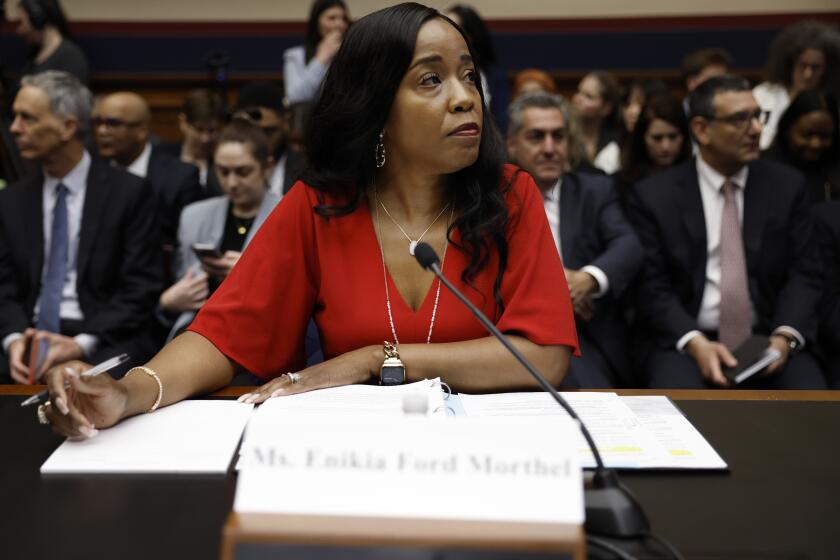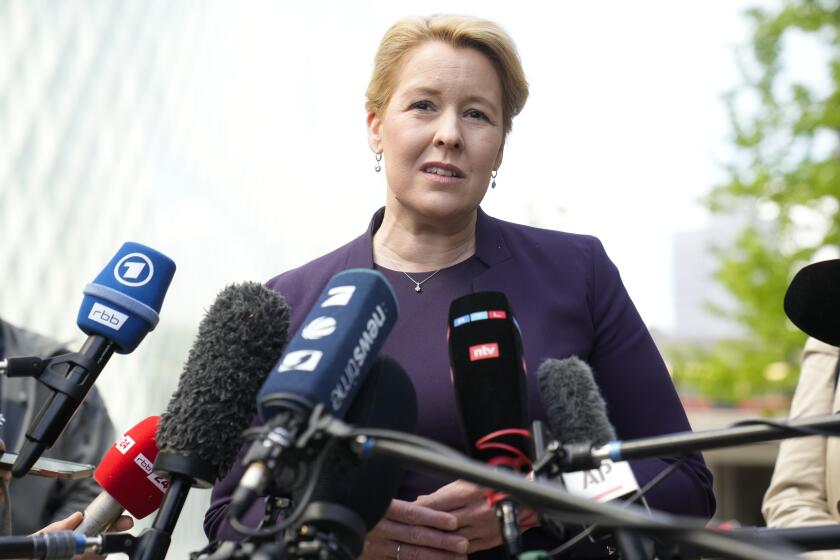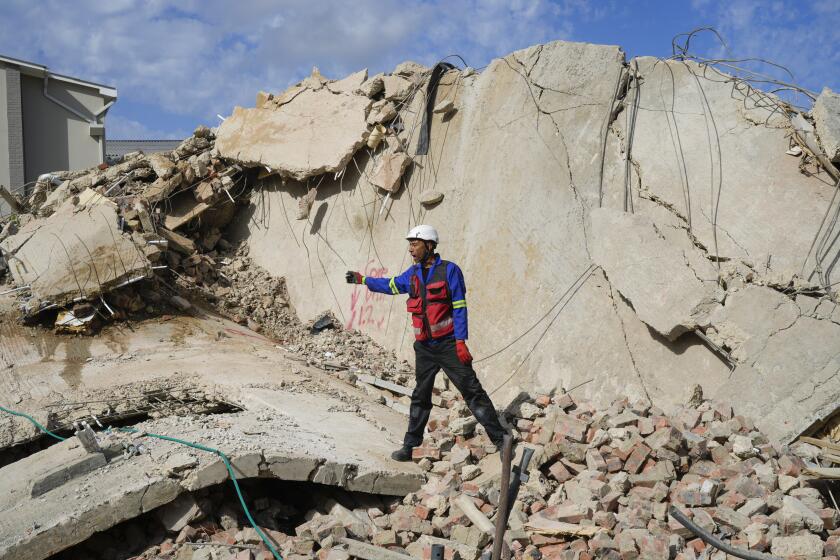Peace Marchers Make It to Chicago : Anti-Nuclear Group Finds Limited Public Reaction
The Great Peace March for Global Nuclear Disarmament has come and gone from here. Having spent four days in this city that named itself “the world’s largest nuclear weapons free zone” earlier this year, the marchers crossed into Indiana last week. They have come more than 2,400 miles since they left Los Angeles on March 1, and are now on the final third of their walk across America to Washington.
“I think Chicago is going to tell us a lot,” Evan Conroy, at 23 the march’s youngest board member, said while the march was in still in Iowa and looking toward Chicago. “Either we are going to become a very large movement or we will leave Chicago a small group of dedicated people.”
It was, comparatively speaking, a small group of dedicated people that left town. Officially they number 680, but probably, most conjecture, mentioning the loosely enforced exit policies, their ranks have thinned to around 500, not all of whom are on the march at any given time.
That is still an extraordinary number of civilians to be on the move over such a vast expanse for such a long time. But while they have reached millions of people thus far, having made personal contacts into the tens of thousands, they have not brought those millions into America’s streets in a groundswell movement to call out with them, “Bring them down.”
Chicago did not give them the cold shoulder. The march had a parade permit and police escorts for its entry march through the Loop at the noon hour. And when it reached Buckingham Fountain in Grant Park, Mayor Harold Washington was there to officially welcome them, proclaiming “Sunday, Aug. 17, 1986, Survival Sunday in the city of Chicago.” And there were free passes and discounts for public transportation and museums.
And although the march’s advance team spent much time and effort that never did result in a site permit to camp in downtown Grant Park, scene of the 1968 violent confrontations between police and protesters during the Democratic convention, the city finally, at zero hour, gave them a place to stay in the northwest section at North Park Village behind the Bohemian National Cemetery.
The media paid attention, both giving them advance publicity and coverage of events. There were invitations to speak in 80 churches and an interfaith service at the Baha’i Temple in Wilmette. Local peace groups invited them to participate in several special events, such as the repairing of the Peace Garden wall and that in turn brought out the camera crews.
America’s best-known disc jockey and broadcaster, Casey Kasem, accompanied by his wife, Jean, took the “red eye” out from Los Angeles, went straight to radio station WLS, where he launched a call-in fund-raiser, then joined the march through the Loop and proceeded to broadcast live from a WLS mobile unit at Buckingham Fountain. He was joined by actor/director Ron Howard. And “Hill St. Blues’ ” Betty Thomas spoke at the Lincoln Park rally, as did Chicago’s writer and radio interviewer Studs Terkel. Peter, Paul and Mary, in town for an outdoor concert at suburban Ravinia, did not make it to the campsite, but did dedicate a song to them at the concert.
And yet. . . .
As far as the general public was concerned, there were times when it seemed Chicago couldn’t have cared less.
That Invisible Feeling
“I never felt so invisible in my life,” Ellen Murphy, 49, of San Diego, said of the march’s parade through the Loop at noon hour. “They (the onlookers) weren’t hostile or unfriendly. They looked right at us and they didn’t see us.”
Before the march reached the city limits, premonitions had been growing in some that they were not going to have the impact they had hoped for.
“I know,” one chuckled ruefully, shaking his head. “It’s a flop.”
This, despite the welcome they had just received on the eve of their entry to Chicago when they camped in LaGrange on the grounds of the Bethlehem Center, an educational complex owned by the Sisters of St. Joseph. The entire community of sisters walked out to the highway, and formed a reception line that was anything but formal. As the marchers turned into the grounds, the sisters embraced many of them, took their hands, thanked and welcomed them, telling them with tears in their eyes how thrilled they were to have them. It was a genuine display that caught the marchers by surprise and overwhelmed them.
There was nothing like that the next day. Through public service announcements and leafleting they had been asking Chicagoans to join the march at the University of Illinois’ campus for the parade through the Loop to Buckingham Fountain. In order to reach the campus, 13 miles from LaGrange, by 10:30 a.m. they had to get up at 3 and hit the road at 5. They were awakened by someone blowing reveille on a bugle, which, marcher John Light, 40, reported later, “pumped us up.”
Black Community Responds
They were further pumped up by the response they met when walking through the black community. People hung out the housing project windows, stopped along the street to honk and cheer, blessed them, shook their hands, wished them well, thanked them. It was by far the most enthusiastic welcome they would receive from the general public.
When they reached the campus, there were about 75 Chicagoans waiting to join them. (In Tiffin, Iowa, just outside of Iowa City, a similar invitation had brought out 250.) Undaunted, the marchers headed for the Loop, hooting, cheering, chanting.
It soon became apparent, however, that the cheering was coming from the parade. The onlookers were silent. For the most part the march got no response. Nothing ugly happened. There were a few wry smiles or head shakes of mild disgust. Most people either paid them no attention or looked on with impassive faces. As a result, when some isolated individual waved or clapped or gave the peace sign, the marchers went wild with gratitude. Such was the response to the woman who held out a peace symbol she was wearing around her neck and burst into tears, and to the group of Asian men, their taxi stalled in traffic, who hung out the windows and gave them the peace sign.
“This doesn’t surprise me,” Bob Hurlbut of nearby River Grove said. An electrical engineer, he had taken the day off and was marching with his wife, daughter and neighbor, having left his two teen-age “Rambo sons” at home. “Everybody’s asleep, walking around in a coma--or they’re inhibited to show anything.”
Terkel in Good Spirits
Later, Studs Terkel would echo that. Survival Sunday brought hundreds, not thousands, to Lincoln Park. Terkel, who had interviewed several marchers on his program a few days earlier, was at the park, looking in good spirits.
“I think people are interested, are sympathetic,” Terkel said. “I know this march represents the deep-seated values of the great many. But when it comes to making the connection with daily life, we’re up against banality, the evil of banality. . . . The American society has to make up its mind if it has a life wish or a death wish. I’ve got a life wish. That’s why I like this march.”
Later, from the podium, he reassured the marchers, “it’s always been a minority. Eventually more and more will speak out.”
Looking back on the weekend, Mary Ann Filbin, director of Chicago’s Peace Museum, was likewise positive.
“The Great Peace March did have an impact. It was not overtly dramatic as in some other cities, but Chicago is a fairly sophisticated town politically. A lot of organizations are headquartered here that do a lot of peace work. People tend to be fairly well versed.”
Thanks to the Peace March, she said, new names were added to the rosters, new people inspired by face-to-face contact.
“That’s the real value of the march. It’s not the big wonderful gesture that was envisioned when PROPeace planned it. (That organization collapsed two weeks after the march left Los Angeles and a new corporation, smaller, scaled down and operating on a slender shoestring, was formed.)
“There is some very sincere educating and organizing going on,” Filbin said of the march’s strength. “I saw it happen here as well. Here at the museum, we see dedicated people all the time. But I must say, the marchers I met were incredible. How they are able to sustain their dedication at a certain pitch for so long--it’s incredible.”
As the evaluations of the Chicago experience now take place, probably few will call it a flop. Many have been questioning the quality of the advance work, of the lack of professionalism that is deliberate among some marchers. Although Peace City (the moving camp) is a more peaceful place of late than it was earlier this summer when ideological differences and grievances were pulling it apart, there are still differences.
For some the whole point of the march is nuclear disarmament, for others it is the experiment of Peace City, providing proof that humans can live in peace, making decisions by consensus. Those with no ideology, the freeloaders who neither march, nor work, nor take an interest in the issues other than an occasional “Hey, peace, man” are now known as “potatoes.” What to make of them, and whether to let them stay has caused much of the dissension between the other two groups.
Regardless of the merits of the debate, it has taken energy and focus from the issue that all are presumably marching for--global nuclear disarmament.
Beyond that there are factors beyond the marchers’ control--the difficulty an intangible issue such as the threat of a nuclear holocaust presents, the mood of the country.
Individual Contacts
Granting the reality of the march as it has developed, and the time and place it is happening in, many are beginning to suggest that it may be that the individual contacts, the message of hope--that individuals can make a difference by getting involved, writing their lawmakers--are the march’s greatest strengths. That the groundswell national movement may not be possible.
“Why are we willing to accept so little?” Allan Affeldt, formerly president of the board of the march and now a marcher, asked one day, sounding exasperated with the ‘experiment in living’ attitude that often seems to take precedence. “It’s a real serious cop-out, this lowering of expectations. The whole point of the peace march is that we don’t have that much time. We’re completely missing the urgency that brought us here.”
There is still enough time, though, he said, to get serious, by which he meant putting together an advisory board for what the march should do in Washington and afterwards, doing coalition work with peace organizations, engaging professional help for fund raising and media, focusing more of the issues of disarmament.
“For all the sophistication we try to attribute to ourselves,” Affeldt said, “I think we have very little in terms of media, fund raising, strategy. So then, our only hope is a real strong spiritual grounding. There is a small group of really dedicated, spiritual people who are here.”
Murphy, the marcher who felt invisible walking through the Loop, seems to be one.
A chemical dependency counselor and consultant from San Diego, and mother of five, she and her husband were supporting her son by a former marriage on the march when it collapsed in Barstow. They had been through some hard financial reverses at the time, she said, but when they got the news they drove all night, “barreling it” to Barstow, taking “all the money we owned, every penny of it.” It was only $500, but its significance to them caused an argument between them as they drove. Murphy wanted to give some of it to the march, her husband wanted to give it all. He won.
By the time they handed the money over to the new march, both had decided that one of them should be on it. Murphy has not seen her husband since June.
Commitment to the March
“It’s really rough to be separated like this, but we do consider this an emergency,” she said adding that her commitment to the march and conviction she ought to be on it has “deepened every step of the way. I find it painful to be aware of the critical state of the planet all day every day. I cry a lot. But’s it’s like the more homesick I get, the more committed I get.”
Her commitment is tried constantly, she admitted, by the presence on the march of the drifters, seekers, lost souls, misfits, crazies. Unwashed, unkempt, often unshod, uninformed, unconcerned and anti-social--they are a problem. They are often young.
“I would be such a liar if I said seeing them in their unkemptness, smelling the pot didn’t bother me. But I’m aware the teen-age suicide rate has tripled. They are the youth that have not eagerly grasped the Reagan route to success. They’re afraid, alienated, have no conception of raising a family. They are the nuclear children.”
She put her face in her hands and started to cry, then made herself continue, fighting her tears, forcing words out of a tight throat:
“How can we say, ‘Oh, hey, you don’t understand. This is an anti-nuclear walk. You’ll have to go.’ How can we feel disgust for the very people,” she said, breaking off again, “for the very people who have been born into this.”
More to Read
Start your day right
Sign up for Essential California for news, features and recommendations from the L.A. Times and beyond in your inbox six days a week.
You may occasionally receive promotional content from the Los Angeles Times.






